Elevate your drone photography with these clever framing techniques. Capture leading lines like roads and rivers to create depth and guide the eye. Utilize natural frames such as circular clearings or tree stands to border your subjects. Seek out symmetry and patterns in landscapes and structures for visually striking compositions. Embrace negative space to emphasize your focal point and add balance. Incorporate diagonal elements for dynamic energy and movement. Layer your shots with distinct foreground, middle ground, and background elements. Finally, play with contrasting colors and textures to add visual interest. These strategies will help you transform ordinary scenes into extraordinary aerial masterpieces.
Key Takeaways
- Utilize leading lines like roads, rivers, and coastlines to create depth and guide the viewer's eye through the landscape.
- Incorporate natural frames such as circular clearings, tree stands, or island formations to border and emphasize focal points.
- Capture layered landscapes by positioning the drone to separate distinct foreground, middle ground, and background elements.
- Exploit symmetry and patterns in both natural and man-made structures to create visually striking compositions.
- Leverage negative space and minimalism to emphasize the main subject and create powerful, balanced aerial photographs.
Leading Lines From Above
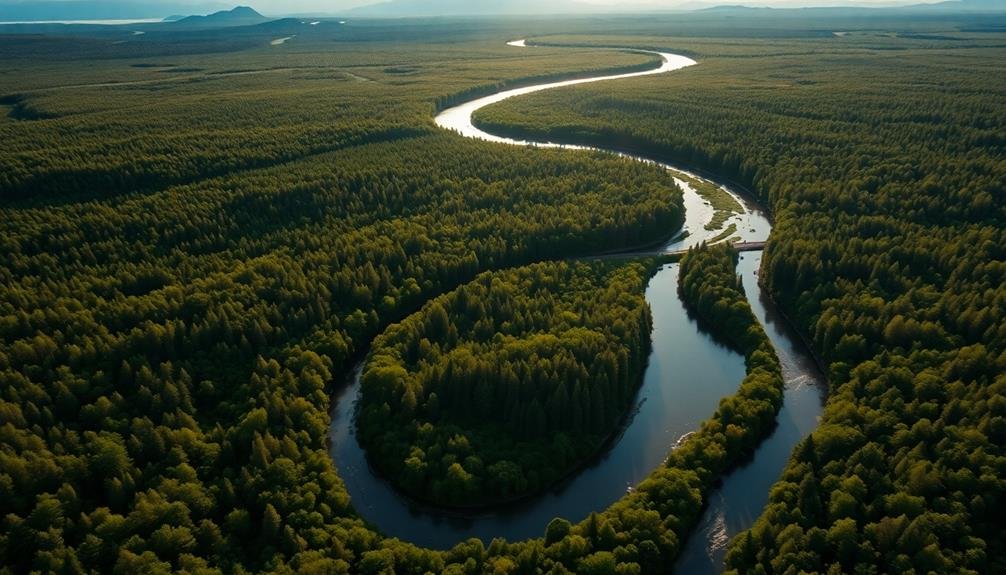
Aerial photography opens up a whole new world of leading lines that you can't spot from the ground. From above, roads, rivers, and fences transform into powerful compositional elements that guide the viewer's eye through your image. Look for long, straight features like highways or train tracks that cut across the landscape, creating a strong sense of direction and depth.
Don't overlook natural formations either. Coastlines, mountain ridges, and tree lines can serve as subtle yet effective leading lines. When you're flying your drone, pay attention to how these elements intersect or converge. You can use them to draw attention to a specific point of interest or to create a sense of movement within the frame.
For added impact, try positioning your drone at different angles relative to these lines. A perpendicular view can emphasize symmetry, while a diagonal approach might convey a more dynamic feel.
Experiment with altitude too; flying lower can make leading lines appear more pronounced, while higher altitudes can reveal patterns you might miss closer to the ground. Remember, the key is to use these lines intentionally to enhance your composition and tell a visual story.
Natural Frames in the Landscape
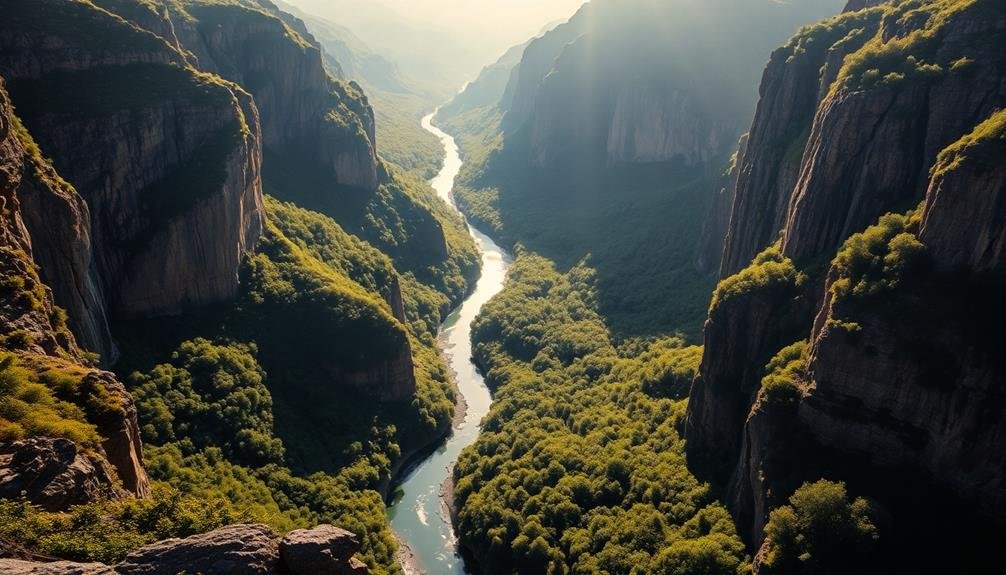
While ground-level photographers often use trees or archways to frame their shots, drone pilots have access to a whole new domain of natural frames. From above, you can seek out circular clearings in forests, meandering rivers that curve around a central subject, or mountain ridges that form a natural bowl.
Look for isolated stands of trees that create a border around open fields, or use the edges of lakes and coastlines to frame inland subjects. You'll find that islands can serve as perfect natural frames for seascapes, especially when they form a crescent shape.
In urban environments, seek out parks or green spaces that create a natural border around city structures. Don't overlook seasonal changes; a partially frozen lake can create a striking frame around unfrozen water.
When using natural frames from above, consider how shadows play into your composition. Long shadows at sunrise or sunset can create additional framing elements.
Remember to adjust your altitude to fine-tune the frame's proportions. By experimenting with height and angle, you can create unique perspectives that showcase the landscape's natural framing elements in ways that ground-based photographers simply can't match.
Symmetry and Patterns
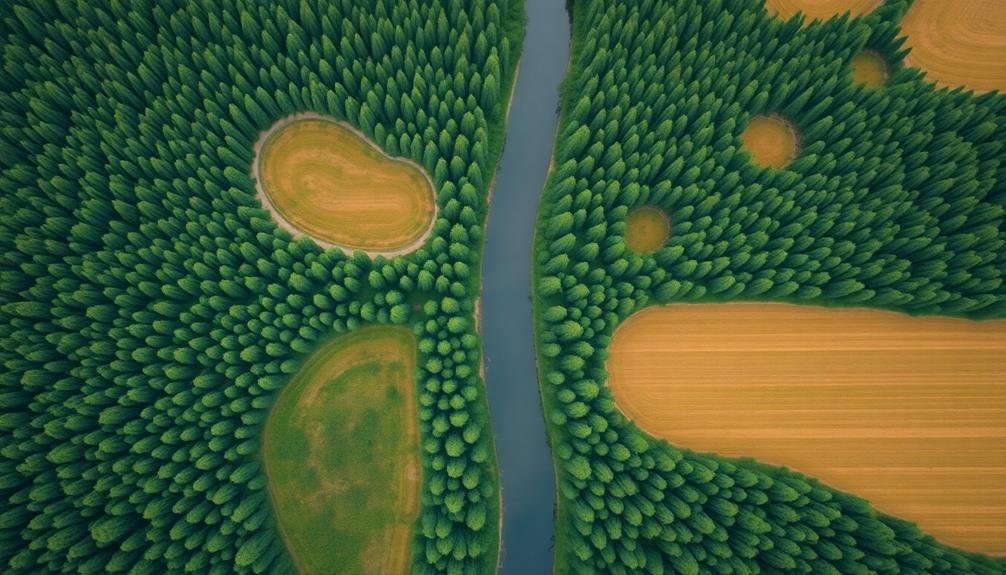
Symmetry and patterns are powerful tools in drone photography that can transform ordinary landscapes into extraordinary compositions. When you're flying your drone, look for naturally occurring symmetry in the environment. Rivers splitting landmasses, roads intersecting fields, or even the shadow of a mountain can create stunning mirror-like effects.
You'll find that man-made structures often provide excellent opportunities for symmetrical shots. Seek out geometric shapes in urban landscapes, such as circular roundabouts, grid-like city streets, or symmetrical buildings. Capture these from directly above to emphasize their perfect balance.
Don't forget to explore patterns in nature. Scan for repeating elements like waves on a beach, rows of crops in farmlands, or the textures of forests. You can create visually striking images by filling your frame with these recurring motifs.
To add depth to your symmetrical compositions, try incorporating leading lines. Roads, shorelines, or even shadows can guide the viewer's eye through the image.
Negative Space for Impact
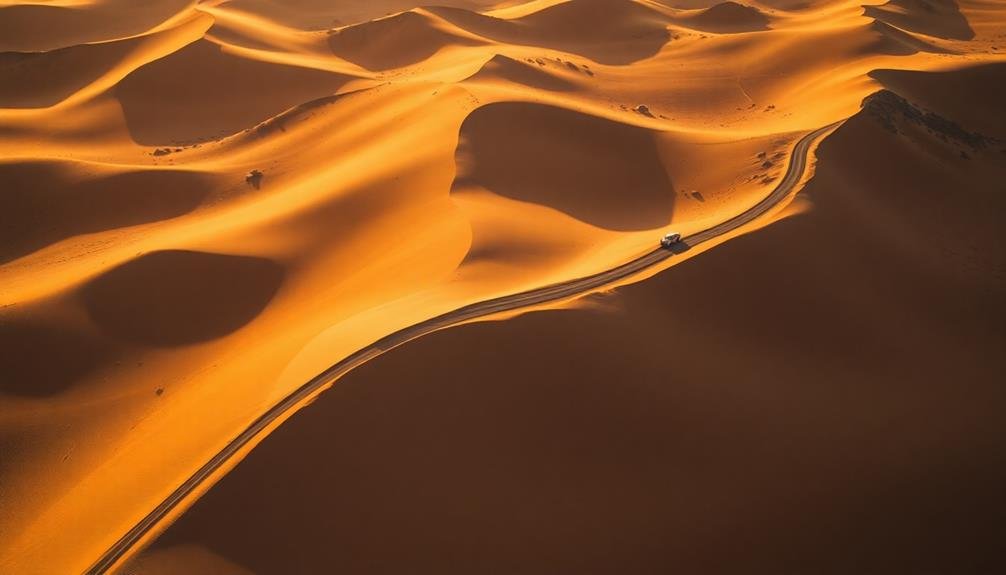
You can harness the power of negative space to create striking drone landscapes.
By surrounding your main subject with emptiness, you'll draw the viewer's eye and create a powerful focal point.
Strategically placing voids in your composition not only balances the image but also adds depth, allowing you to craft more impactful and visually compelling aerial photographs.
Emphasize Subject With Emptiness
In drone photography, negative space can be your secret weapon for creating powerful landscape images. By using emptiness strategically, you'll draw attention to your main subject and create a sense of scale and drama. To emphasize your subject with emptiness, position it off-center and surround it with vast, open areas.
Consider these techniques to maximize the impact of negative space:
| Technique | Effect |
|---|---|
| High altitude | Increases open sky |
| Low altitude | Emphasizes ground textures |
| Tilted angle | Creates dynamic composition |
| Symmetry | Balances emptiness |
| Minimalism | Simplifies the frame |
When framing your shot, look for natural elements that can act as leading lines or frames within the negative space. Clouds, shadows, or patterns in the landscape can guide the viewer's eye to your subject. Don't be afraid to leave large portions of your frame empty; this emptiness can evoke emotions and tell a story about the landscape's vastness or isolation.
Experiment with different altitudes and angles to find the perfect balance between your subject and the surrounding emptiness. Remember, the goal is to use negative space to enhance your subject, not overshadow it.
Balance Composition Through Voids
While emphasizing subjects with emptiness is powerful, balancing your composition through voids takes negative space to the next level. This technique involves strategically placing your main subject off-center and using the surrounding empty space to create equilibrium in your drone shots.
To achieve this balance, employ the rule of thirds. Divide your frame into a 3×3 grid and position your focal point at one of the intersecting lines. Then, use the remaining space to counterbalance the visual weight of your subject. This approach creates tension and interest, drawing the viewer's eye across the entire image.
Experiment with different ratios of subject to void. A small subject surrounded by vast emptiness can evoke feelings of isolation or insignificance, while a larger subject balanced by strategically placed voids can create a sense of harmony and stability.
Consider the shape and texture of your voids. Smooth, uninterrupted spaces can provide a calming effect, while textured or patterned voids can add depth and complexity to your composition.
Create Depth Using Space
Depth in drone photography isn't just about capturing vast landscapes; it's about strategically using negative space to create impact. By incorporating areas of emptiness or simplicity in your composition, you'll add depth and draw attention to your main subject.
Look for opportunities to juxtapose your focal point against expansive areas of sky, water, or open terrain. This contrast will make your subject pop and create a sense of scale. Try positioning your main element in the lower third of the frame, leaving the upper portion open to emphasize the vastness of the scene.
Experiment with different altitudes to manipulate the amount of negative space. Flying higher can increase the empty areas around your subject, while lower flights might reduce them. Use leading lines within the landscape to guide the viewer's eye through the negative space towards your focal point.
Don't be afraid to leave large portions of your frame seemingly empty. These areas aren't truly vacant; they're working to enhance the overall composition and create a more powerful visual narrative.
Dynamic Diagonal Compositions

Dynamic diagonal compositions in drone photography can breathe life into your landscape shots. They create a sense of movement and energy, guiding the viewer's eye through the frame. In order to achieve this effect, look for natural diagonal lines in the landscape, such as winding roads, rivers, or mountain ridges.
Position your drone to capture these elements at an angle, emphasizing their diagonal nature. You can also create diagonal compositions by tilting your drone's camera. This technique works particularly well when shooting coastlines or forest edges, as it adds a dynamic twist to otherwise straight horizons.
Experiment with different angles to find the most visually appealing composition. Another effective method is to use shadows as diagonal elements. Early morning or late afternoon light casts long shadows that can create striking diagonal patterns across the landscape.
Look for interesting textures or patterns on the ground that can be enhanced by these shadows. Don't forget to take into account the rule of thirds when composing your diagonal shots. Place key elements at the intersection points of the grid to create a balanced and visually pleasing image.
Layered Landscapes
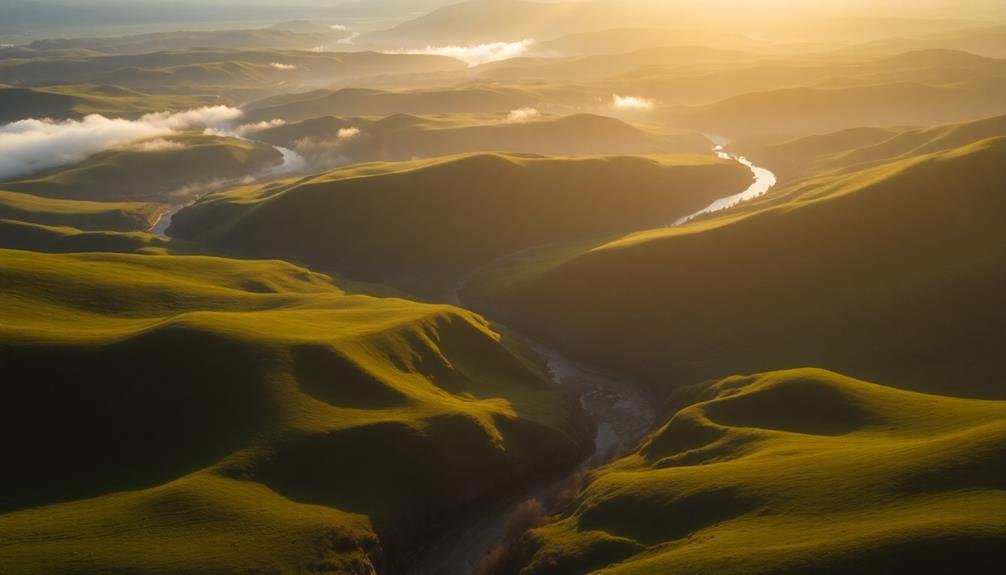
Layered landscapes often create stunning visual depth in drone photography. You'll want to look for scenes with distinct foreground, middle ground, and background elements to capture this effect. Mountains, valleys, and coastlines are ideal subjects for layered compositions.
To enhance the layered effect, position your drone at an angle that clearly separates each plane. Try flying at a higher altitude to capture more expansive views, allowing you to include multiple layers in a single frame.
Pay attention to lighting conditions, as early morning or late afternoon sunlight can accentuate the depth between layers. Use leading lines to guide the viewer's eye through the layers, such as rivers, roads, or ridgelines.
Experiment with different focal lengths to compress or expand the perceived distance between layers. A longer focal length can make distant mountains appear closer to the foreground, while a wider angle emphasizes the space between layers.
Consider incorporating elements like fog, mist, or clouds to add atmospheric depth. These natural phenomena can create additional layers and soften changes between planes, resulting in a more ethereal and enchanting image.
Contrasting Colors and Textures
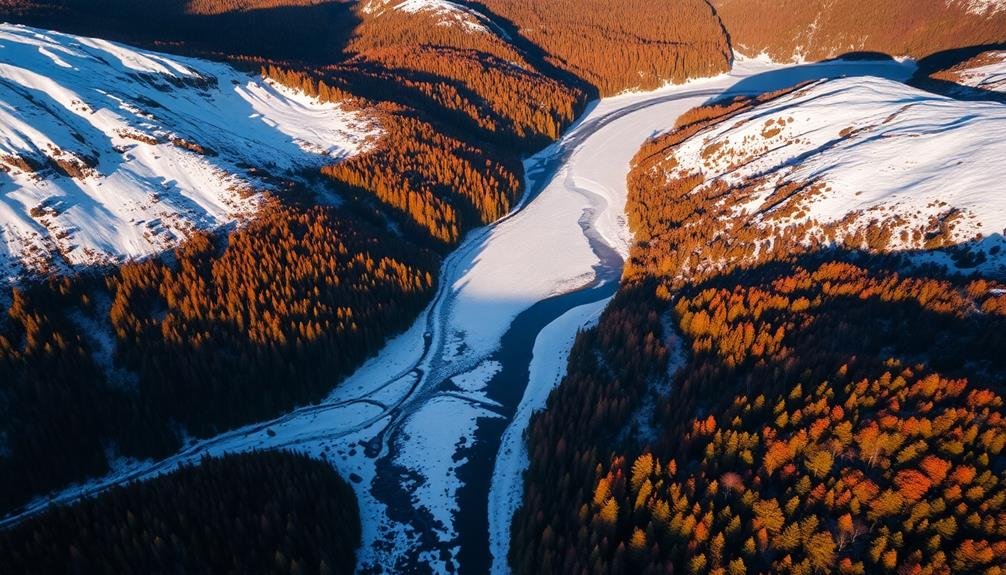
Harnessing the power of contrasting colors and textures can dramatically elevate your drone landscape photography. Look for scenes that juxtapose different hues and surfaces to create visually striking compositions. You'll find that opposing elements often create the most enchanting images.
Consider these contrasting elements in your drone shots:
| Color Contrasts | Texture Contrasts | Lighting Contrasts |
|---|---|---|
| Blue sky vs. green fields | Smooth water vs. rocky shore | Sunlit areas vs. shadows |
| Autumn foliage vs. snow | Urban structures vs. natural landscape | Golden hour vs. blue hour |
| Desert sand vs. oasis | Farmland patterns vs. forest | Artificial lights vs. natural light |
| Volcanic rock vs. lush vegetation | Rippled sand dunes vs. flat plains | Reflections vs. solid surfaces |
| Colorful buildings vs. neutral surroundings | Textured clouds vs. clear sky | Backlit subjects vs. front-lit scenes |
When composing your shot, position these contrasting elements strategically within the frame. Use the rule of thirds or symmetry to create balance. Experiment with different altitudes and angles to maximize the impact of these contrasts. Don't forget to adjust your camera settings to properly expose for both light and dark areas, preserving details in all parts of your image.
Frequently Asked Questions
What Drone Regulations Should I Be Aware of Before Landscape Photography?
You'll need to know airspace restrictions, altitude limits, and registration requirements. Check local laws, avoid no-fly zones, and respect privacy. Always maintain visual line of sight and don't fly over people or moving vehicles.
How Can I Improve Battery Life for Longer Drone Photography Sessions?
You'll get more flight time by carrying spare batteries, reducing drone weight, flying in ideal conditions, and using power-saving modes. Don't forget to keep your batteries warm and avoid overcharging. Plan your shots efficiently to maximize battery life.
What Are the Best Weather Conditions for Capturing Drone Landscape Photos?
You'll get the best drone landscape photos in calm, clear conditions. Aim for golden hour lighting at sunrise or sunset. Avoid strong winds and rain. Overcast days can work well for soft, even lighting.
Which Editing Software Is Recommended for Enhancing Drone Landscape Photographs?
You'll find Adobe Lightroom and Photoshop are top choices for enhancing drone landscape photos. They offer powerful tools for color correction, sharpening, and exposure adjustments. DJI's built-in software and Capture One are also great options to contemplate.
How Do I Protect My Drone and Camera Equipment During Transport?
You'll want to invest in a sturdy, padded case for your drone and camera gear. Use foam inserts to customize compartments, secure loose items, and don't forget to remove batteries. Always carry your equipment as hand luggage when flying.
In Summary
You've now got seven powerful techniques to elevate your drone photography. By using leading lines, natural frames, symmetry, negative space, diagonals, layers, and contrasts, you'll create stunning aerial landscapes that captivate viewers. Don't be afraid to experiment with these methods, combining them for even more impactful shots. Remember, practice makes perfect. The more you fly and shoot, the better you'll become at spotting and framing these unique perspectives from above. Happy droning!

As educators and advocates for responsible drone use, we’re committed to sharing our knowledge and expertise with aspiring aerial photographers.




Leave a Reply